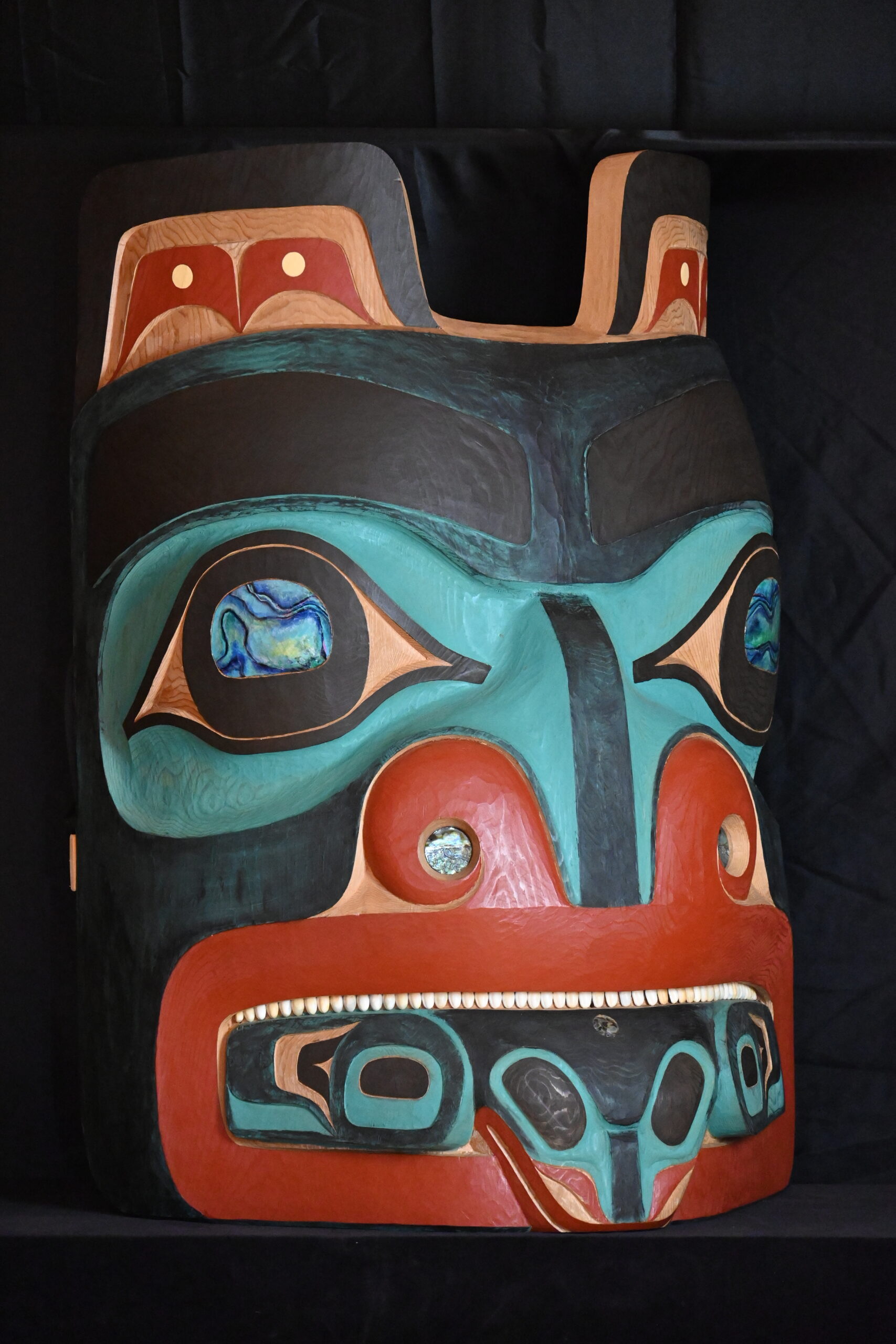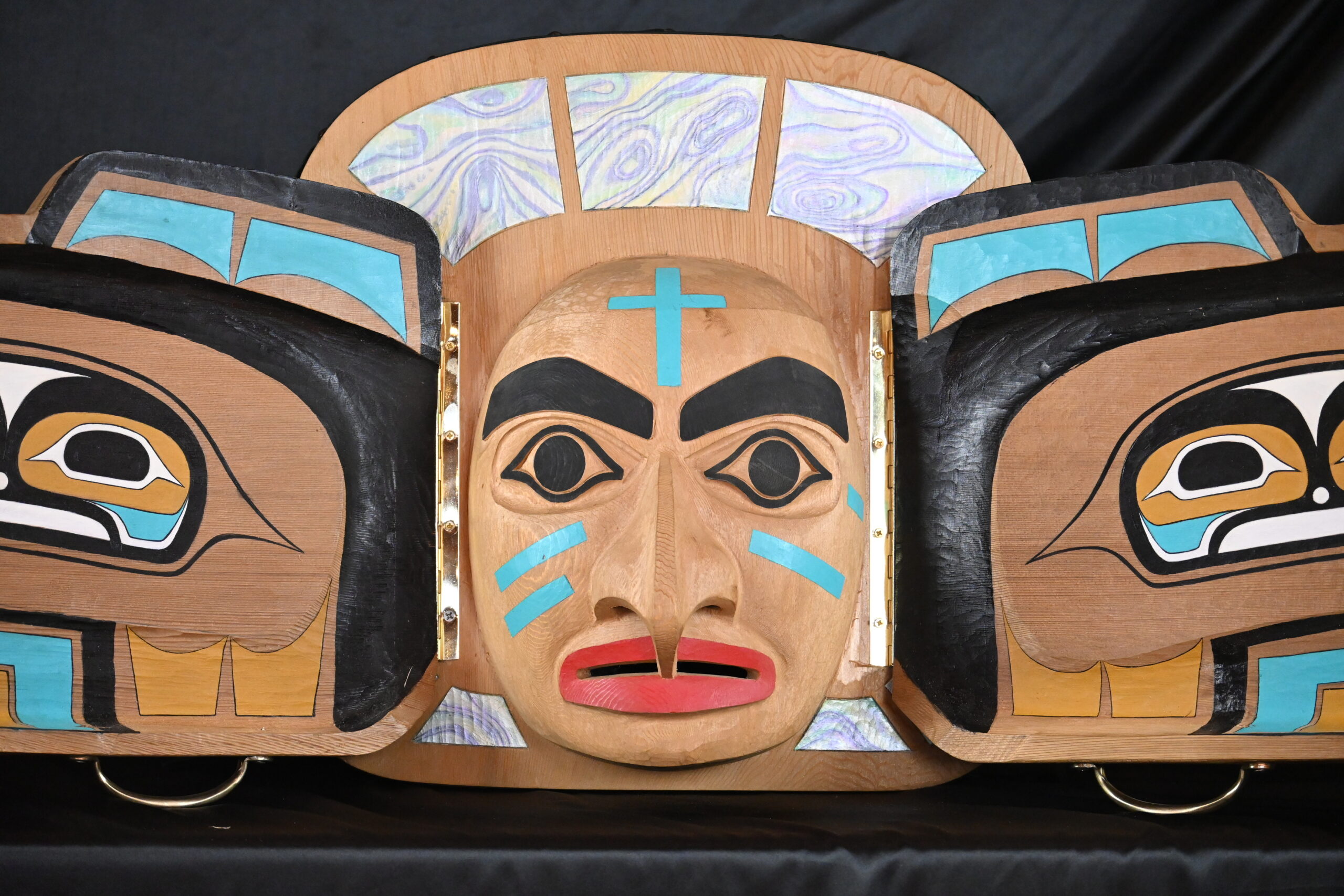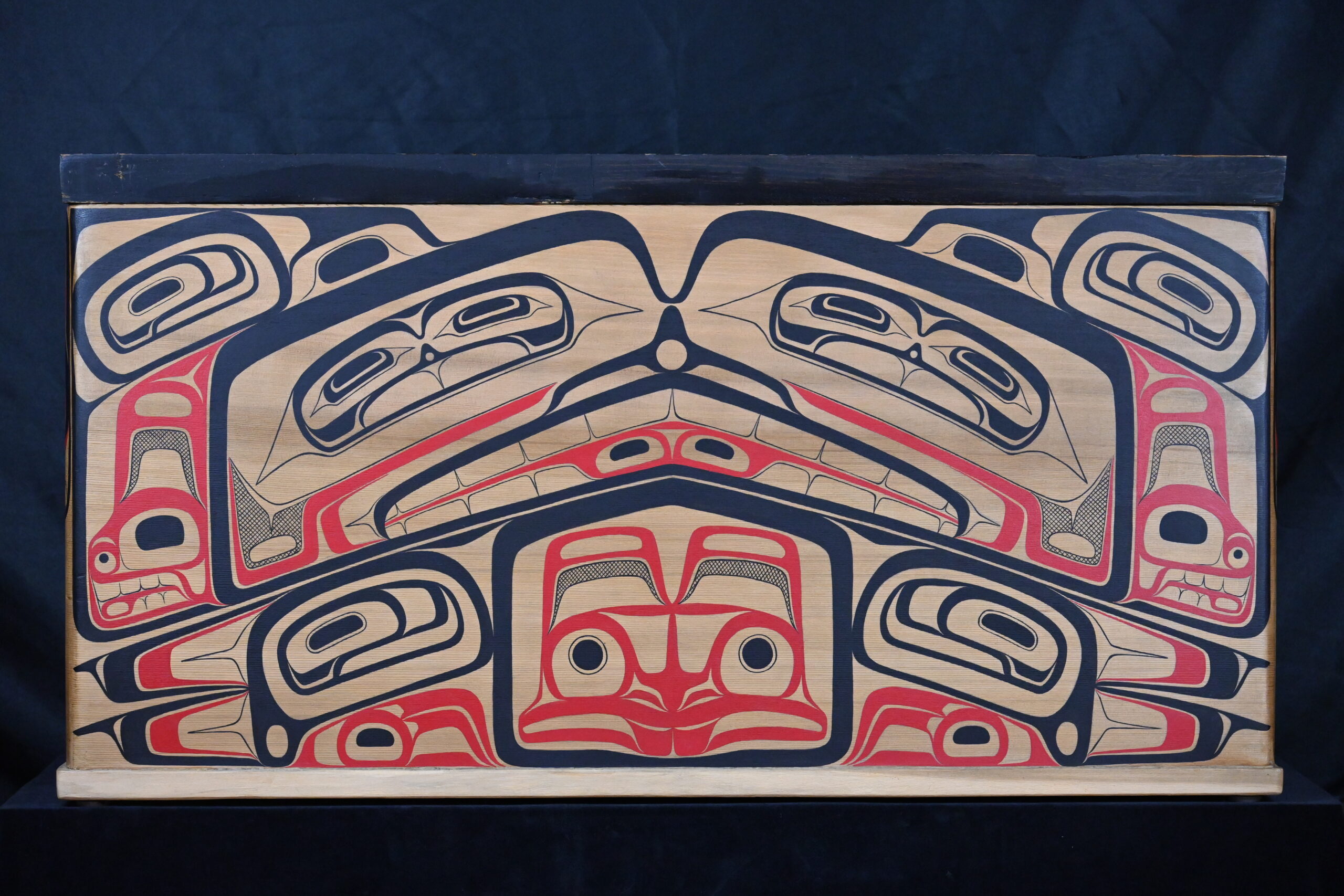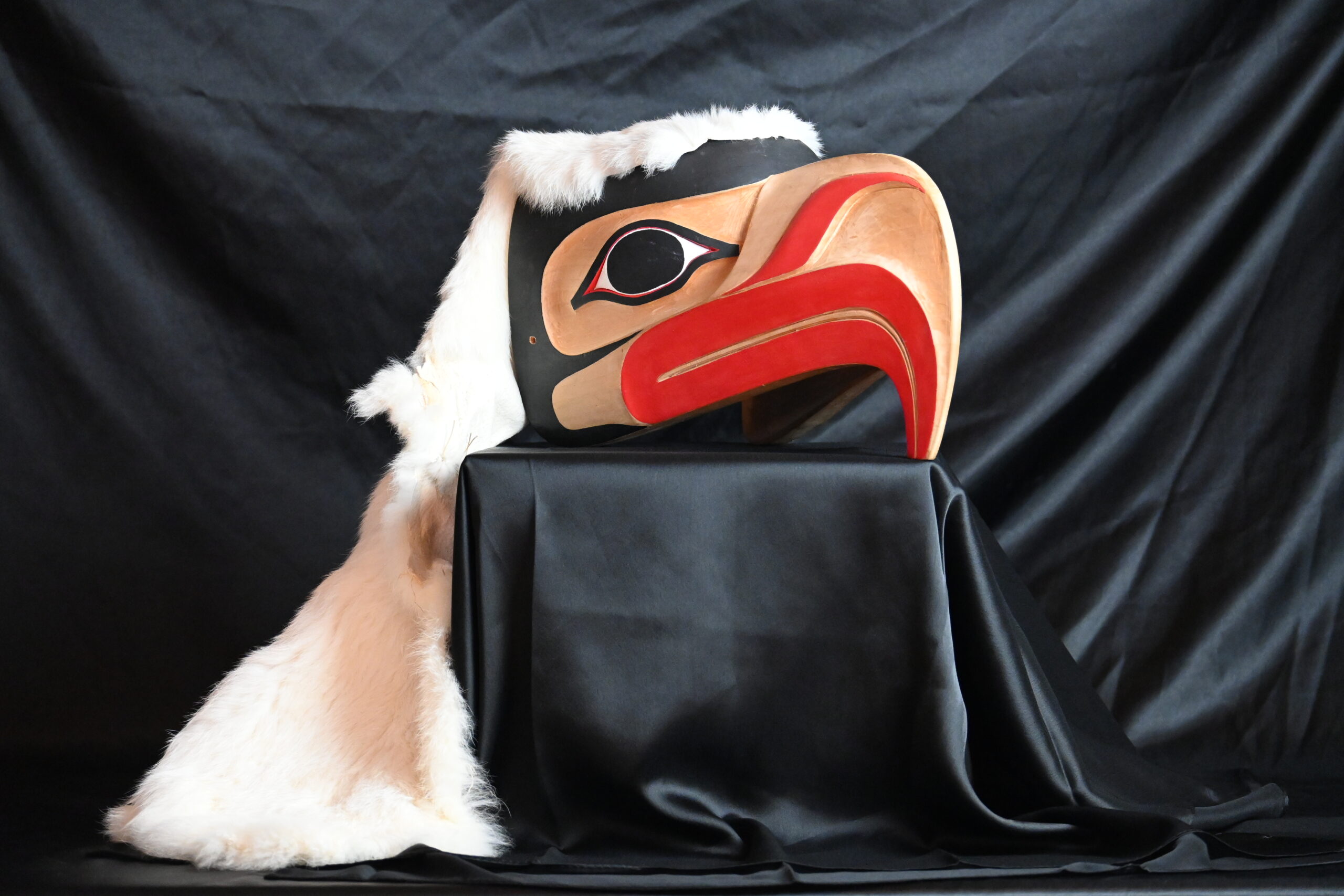Kihl ‘Yahda Christian White was 14 when he began carving with argillite, a fragile sedimentary rock quarried by Haida artists on the archipelago of Haida Gwaii. White learned at the side of his father, the late chief of the Edensu (Edenshaw) Eagle Clan of Kiusta, Morris White. By the age of 17, White was a full-time artist, his work reflecting the stories, songs, and dances of Haida culture.
“It seemed natural for me to carve,” White says, “as if my hands are guided.”
Now, for the first time, a retrospective of the prolific artist’s multidisciplinary work spanning 50 years is on show at the Bill Reid Gallery in Vancouver. Kihl ‘Yahda Christian White: Master Haida Artist showcases more than 40 pieces, from sculptures and masks to jewellery, regalia, and prints. Also featured are White’s collaborative works with eight apprentice Haida artists.
Raven Dancer is a stunning argillite carving that depicts a raven donning a robe and dancing with a rattle. The sculpture contains meticulous inlay work, each varied stone and shell animating the figure. According to guest co-curator Sdahl Ḵ’awaas Lucy Bell, “This incredible and intricate sculpture feels like a reflection of Christian himself,” and she notes that the Raven image reoccurs in many of White’s argillite carvings.
Seal Carving, a small figure made from whale bone, was carved by White when he was 12. Two years later, he created Raven Copper Shield as a gift for his mother, Dian White. His father assisted with the design engraved on the shield, the teenage White still learning to create his own forms. Both pieces offer the viewer a window into the creative origins of a master carver, appearing in conversation with later works like Raven Dancer.

Ts’aan Xuujii (Sea Grizzly) by Kihl ‘Yahda Christian White.
During White’s early years, he had few cultural references to draw from. His father, who began carving in his 40s, was a main source of inspiration. Later, other elders would share their carvings and traditional techniques.
“Most of the art had been taken by missionaries and other collectors,” White says. “There’s been an upsurge in our art and a passing on of the culture to the next generation. It’s great to be at the Bill Reid Gallery and to educate people who come here. They can view our community through this lens.”
White was born in Queen Charlotte City in 1962, a member of the Yahgulaanas Haida Raven Clan, and raised nearby in Old Massett. The community is on the northern shore of Graham Island, one of more than 150 islands in Haida Gwaii. White has continued to reside there along with his wife, Candace Weir-White, a song and dance leader. The couple have three children and five grandchildren.
A well-used wooden desk offers a glimpse into White’s home and workspace. Long-arm lamps clamped to each side of the desk tower over a chunk of argillite surrounded by carving tools. Other items scattered about include family photos, fishing gear tucked in shelving, and an art book on White’s ancestor, famed Haida artist Charles Edenshaw.
The carvings on show are made with wood sourced from the forests of Haida Gwaii. Alder is typically used to carve masks and rattles. “You have to work quickly if it’s alder,” the artist says. “Indoors it gets hard and dry. Cedar you can put aside and use two years later.”
Giant Raven, a cedar and acrylic mask, is eight feet long and weighs 50 pounds. Carved by White alongside apprentices Ken Hans, Vernon White, and Gwaliga Hart, the bird’s beak opens and closes to make a loud clapping noise, with the aid of a pulley device. A performer donned the mask at the grand finale of a pole-raising ceremony in 2022, White says, and danced to a drummer’s beat.
Another enormous carved mask called Raven Transformation is also made of cedar and acrylic, created by White with the assistance of apprentices Vernon White, Ken Hans, and Danielle Allard. The raven’s head opens to reveal a series of inner masks, demonstrated in a video performance by White and the Tluu Xaada Naay Dance Group.

Raven Transformation by Kihl ‘Yahda Christian White.
“These masks have been danced in potlatches over the years,” White says, referencing the gift-giving and feasting ceremony that was banned by law from 1885 to 1951 as part of the Canadian government’s assimilation policy. Its revival has been a vital part of the Haida Nation’s cultural resurgence. “My family has hosted many feasts and potlatches.”
Retention of art pieces within the Haida community has also been important to White. While hundreds of his creations have been sold worldwide, he holds a portion of his work, including several masks.
“This art is of value to us. We don’t have to sell everything. We can keep the art for our own collections.”
Haida art is known for its formlines—continuous curving lines—along with ovoid and U-form shapes. The design, typically painted in red and black, is found on totem poles, canoes, long houses—and bentwood boxes.
Found Bentwood Box, a flattened cedar box made in the 1860s, is decorated with a Haida design on one side and hangs in a gallery installation replicating a partially exposed wall. The box was found hidden inside the wall of a house built in the 1920s in Haida Gwaii. White’s uncle discovered it when the house was torn down.
White believes an experienced artist created the design. “It tells a story. It was probably used as a toolbox. The formline design on the box is still visible.” He carved Replica Bentwood Box 2024 with cedar and displays it next to the recovered 19th-century box. White’s design was assisted by his apprentice and niece, Daisy White.
“Bentwood boxes can be used for storing food, for regalia, even cooking,” White says. “A box was used from birth to burial. They come in many sizes.”

House Chest by Kihl ‘Yahda Christian White.
White has travelled extensively to help bring home the remains of more than 500 Haida ancestors in his role as a founding member of the Haida Repatriation Committee. Plywood boxes are generally used for transport of remains and burial service, he says. To honour the remains of his Haida ancestors in a more respectful way, White decided to build a collection of bentwood boxes. Apprentice Danielle Allard assisted him, tracing his designs onto the sides of the bentwood boxes and painting each in acrylics.
In the carving shed in Old Massett, White and the apprentices work on several projects at the same time. Wood chips from their many carvings were collected for the exhibit and now blanket display cases like fallen leaves.
“This shows the time put in to carve,” White says. “It takes one chip at a time until you slowly get the shape of what’s revealed.”
Kihl ‘Yahda Christian White: Master Haida Artist launched on February 1, 2025, and runs until February 1, 2026, at the Bill Reid Gallery of Northwest Coast Art in Vancouver.









